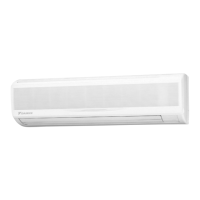8
English
• Before brazing refrigerant piping, have nitrogen ow
through the refrigerant piping and substitute air with
nitrogen (NOTE 1) (Refer to Fig. 13). Then, carry out
brazing (NOTE 2).
After all the brazing works are nished, carry out are
connection with the indoor unit. (Refer to Fig. 12)
Pressure reducing valve
Nitrogen
Taping
Stop valve
Brazing place
Nitrogen
Refrigerant piping
Fig. 13
NOTE
1. The proper pressure for having nitrogen ow through the
piping is approximately 2.9 psi (0.02 MPa), a pressure
that makes one feel like breeze and can be obtained
through a pressure reducing valve.
2. Do not use ux when brazing refrigerant piping.
Use phosphor copper brazing ller metal (BCuP-2: B-
Cu93P-710/795: ISO 3677) that does not require ux.
(If chlorinated ux is used, the piping will be corroded
and, in addition if uorine is contained, the refrig erant
oil will be deteriorated and the refrigerant circuit will be
affected badly.)
3. When carrying out leak test of refrigerant piping and the
indoor unit after the installation of indoor unit is nished,
conrm the connecting outdoor unit installation manual
for test pressure.
Refer to the outdoor unit installation manual or technical
document for refrigerant piping.
4. In case of refrigerant shortage due to forgetting addi-
tional refrigerant charge etc., it will result in malfunctions
such as not cooling or heating.
Refer to the outdoor unit installation manual or technical
document for refrigerant piping.
CAUTION
Do not use antioxidant when brazing piping.
It may result in malfunction of components and clogging of
piping due to residue.
6. DRAIN PIPING WORK
(1) Carry out drain piping.
Carry out drain piping so that drainage can be ensured.
• Select the piping diameter equal to or larger than
(except for riser) that of the connection piping (PVC,
nominal diameter 1 in. (25mm), outside diameter 1-1/4
in. (32mm)).
• Install the drain piping as short as possible with down-
ward inclination of 1/100 or more where air cannot
stagnate. (Refer to Fig. 14) Bubbling sound may occur.
Downward
inclination of
1/100 or more
3–5 ft. (1–1.5 m)
Support
Good
Wrong
(Field supply)
Drain socket
(Field supply)
(Accessory)
Fig. 14
CAUTION
If drainage stagnates in the drain piping, the piping may get
clogged.
(Components contained in silver-based antibacterial
agents may precipitate out and adhere to the drain piping.)
• If sufcient downward inclination cannot be ensured,
carry out upward drain piping.
• Install supports at a distance of 3–5 ft. (1–1.5 m) so that
the piping may not deect. (Refer to Fig. 14)
• Make sure to use the attached drain hose (1) and the
metal clamp (2).
Insert the drain hose (1) into the drain socket up to the
point where the socket diameter becomes larger.
Put the metal clamp (2) to the taped hose end and
tighten the metal clamp (2) with torque 1.00±0.11lbf·ft.
(1.3 5±0.15N·m).
Metal clamp (2)
(Accessory)
Drain socket
Tape
(Accessory)
Fig. 15
CAUTION
• Do not tighten the metal clamp (2) with the torque more
than the specied value.
The drain hose (1), the socket or the metal clamp (2) may
be damaged.
• Wrap vinyl tape around the end of the metal clamp (2)
so that the sealing material (Large) (10) to be used at the
next process may not be damaged with the clamp end
or bend the tip of the metal clamp (2) inward as shown.
(Refer to Fig. 16)
01_EN_3P693452-2.indd 8 2022/08/09 16:00:12

